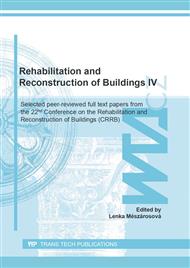p.49
p.57
p.67
p.73
p.81
p.87
p.93
p.101
p.107
Verification of the Use of a Kučera Drill for Testing of Wood Properties
Abstract:
In common practice, we encounter cases where it is not possible to test the wood quality by destructive methods and it is, therefore, necessary to use non-destructive or semi-destructive methods, especially when the wood is already used in construction. The article deals with the methodology of non-destructive and semi-destructive testing of wooden structures using the methodology commonly used for the diagnosis of masonry structures, where mortar strength is tested using a so-called Kučera drill, and with verification of the applicability of this method in the testing of wood properties. Kučera drill was specially modified for the purpose of the experiment and its functionality was tested. The depth of penetration of the drill into the test specimen was tested. The article describes the principle of measurement and the design of the initial experiment, but also the pitfalls, which had to be faced.
Info:
Periodical:
Pages:
107-112
Citation:
Online since:
August 2021
Authors:
Price:
Сopyright:
© 2021 Trans Tech Publications Ltd. All Rights Reserved
Share:
Citation:


